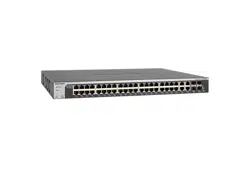Loading ...
Loading ...
Loading ...

Configure Routing
173
ProSAFE 10-Gigabit Smart Managed Switch XS728T and XS748T User Manual
Depending on the type of route that you are creating, specify the following information:
a. In the Network Address field, specify the IP address for the destination.
b. In the Subnet Mask field, specify the subnet mask for the attached network.
c. In the Next Hop IP Address field, specify the outgoing router IP address to use
when forwarding traffic to the next router (if any) in the path toward the destination.
The next router is always one of the adjacent neighbors or the IP address of the local
interface for a directly attached network.
d. In the Preference field, specify the preference (sometimes called administrative
distance), which is an integer value from 1 to 255.
You can specify the preference value (sometimes called administrative distance) of
an individual static route. Among routes to the same destination, the route with the
lowest preference value is the route entered into the forwarding database. By
specifying the preference of a static route, you control whether a static route is more
or less preferred than routes from dynamic routing protocols. The preference also
controls whether a static route is more or less preferred than other static routes to the
same destination.
7. Click the Add button.
The static route is added to the switch.
8. To refresh the page with the latest information about the switch, click the Update button.
The following table describes the nonconfigurable information that is displayed.
Table 44. Learned Routes information
Field Description
Route Type The type of route: Static or Dynamic, depending on how the route was added.
Network Address The IP address for the destination.
Subnet Mask The subnet mask for the destination.
Protocol This field states which protocol created the specified route. The possibilities are one of the
following:
• Local
• Static
Next Hop Interface The outgoing router interface to use when forwarding traffic to the destination.
Next Hop Address The outgoing router IP address to use when forwarding traffic to the next router (if any) in
the path toward the destination. The next router is always one of the adjacent neighbors
or the IP address of the local interface for a directly attached network.
Preference The preference value for the configured next hop.
Loading ...
Loading ...
Loading ...
